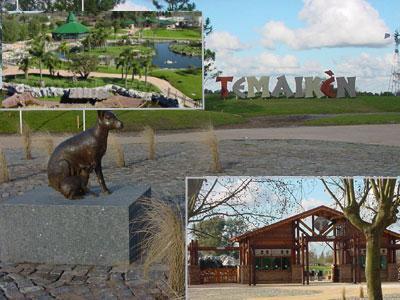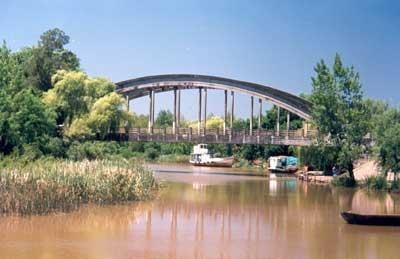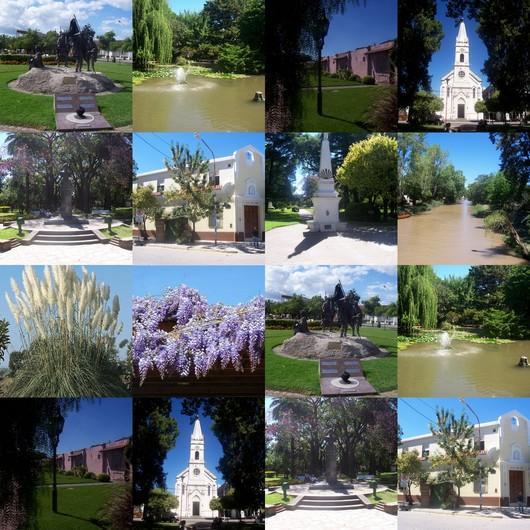Belén de Escobar, Buenos Aires Province, Argentina
Suggest Place to Visit
4071
Track to location with GPS |
 |
Before the arrival of the whites, Guaraní tribes inhabited the place due to its proximity to the Paraná de las Palmas and Luján rivers. With the arrival of the whites, the lands were among the first distributed by Juan de Garay after the second founding of Buenos Aires, the first owner being Pedro de Savas y Espeluca; However, two years after the founding of Buenos Aires - in 1582 - the lands were handed over to Alonso de Escobar, by virtue of this it is that the property begins to be known as Cañada de Escobar and later as Isla de Escobar. Federico Kirbus develops in his book La primera de las tres Buenos Aires (1980), a theory in which he assures that between the area of the ravines of the current neighborhood Parque El Cazador and the coast of the Luján river was the true place where Pedro de Mendoza made the first foundation of Buenos Aires.
The extensions were being subdivided and populated by Spaniards and Creoles until at the end of the XIX century the railway station of Buenos Aires and Campana arrived, which was called Escobar. The arrival of the railroad between 1876 and 1877 was essential for Eugenia Tapia de Cruz, owner of the land adjacent to the original halt, decided to measure about 80 hectares for the creation of a town, reserving two blocks as green spaces - of which only he made one, known as Plaza San Martín - and for the construction of the future Catholic church of the Nativity of Our Lord Jesus Christ, also relying on the existence of some houses in the area. Eugenia Tapia had inherited part of the land from her husband José Antonio Cruz, who died in 1838, and bought the rest from her children in 1864. March 4, 1877 is taken as the town's founding date, this is the day that it actually began. the auction of the town of Belén, carried out by the auctioneer Lisandro Medina. Ten years later the first chapel of the place is blessed, and a year later the promoter of the town died. In 1878 the first industry began to operate, a flour mill of the Ferrari family.
On October 8, 1959, the Escobar party was created, with part of the parties of Pilar and Tigre, designating Belén as its head. A year later, a provincial decree declares the Town of Belén de Escobar City, unifying in the name of the town the original designation with that of the party.
In 1916, the Banco Hogar Argentino bought some parcels in the place known as El Cazador on the ravines of the Luján river, which would later be sold to form what would become known as the Parque El Cazador neighborhood. In the middle of the 20th century, fruit and vegetable production were the economic pillars of the area; Hand in hand with these, Escobar became one of the largest flower producers in the country, a fact that motivated a group from the Rotary Club to create the Flower Festival, the success of it led to President Arturo Illia declaring Escobar as the National Flower Capital in 1964. This designation would later be complemented with the creation of the Japanese Garden, a symbol of the area, donated by the Japanese community and developed by the engineer Yasuo Inomata.
At the beginning of the millennium, the Temaikén zoo was inaugurated.
Belén de Escobar —or simply Escobar— is the head city of the Escobar district, located in the northeast of the province of Buenos Aires, Argentina. It is located in the center of the district, at the intersection of Provincial Route 25 and the Pan-American Route, about 50 kilometers from the city of Buenos Aires. The growth of the Greater Buenos Aires Agglomerate over this route caused a continuous building layout to be formed on it, with Belén de Escobar finally joining the aforementioned agglomerate in the final decades of the 20th century. The absence of spaces in the towns closest to the city of Buenos Aires, encouraged the acquisition of land in more remote places, favoring Belén de Escobar, among other towns, which became one of the fastest growing residential areas in Greater Buenos Aires. Aires.
The lands were known in the 19th century as Cañada de Escobar, Pagos de Escobar or Isla de Escobar, named after Alonso de Escobar, who was one of the first owners of the place. When Eugenia Tapia de Cruz decided to subdivide some 80 blocks for the creation of a town, she chose the name of Bethlehem for herself, in honor of the birthplace of Jesus of Nazareth, since she was very devoted to the image of the child Jesus; the choice of the name was also influenced by the existence until 1779 of a hospital called Our Lady of Bethlehem, maintained by the religious order of the Bethlemite Fathers. Both names coexisted until in 1960 a provincial decree unifies both names declaring the Town of Belén de Escobar City.
Today it is much more common to hear the city referred to as Escobar, since this name not only designates the party of which it is the head, but also the railway station located in the center of the urbanization.
Escobar's Party is located NE of the province of Buenos Aires, Argentina. The main city is Belén de Escobar; It is made up of the cities of Matheu, Ingeniero Maschwitz, Garín and Maquinista Savio.
Escobar is a flourishing municipality and is an alternative for the weekends, since it offers just 50 km from the Federal Capital numerous green spaces, the much prized Japanese Garden, the Barrio Parque area, the Barrancas del Cazador, the unmissable Camino to Paraná, the island area and Paraná de las Palmas with its incredible Delta of wild nature.
The sounds, aromas and colors of nature will keep you company throughout the tour, appreciating them in the wilds of its forests, ravines and wetlands.
Get to know the many attractions that Belén de Escobar offers, enjoy being in contact with nature in this wonderful paradise that is waiting for you.
Comments
We don´t have yet any comments about:
Belén de Escobar
Belén de Escobar
Be the first to leave a comment as it is very important to inform other people
Outros locais a visitar
Within a radius of 20 km from:Belén de Escobar
Escobar |
| 0,2 Km |
 |
Bioparque Temaikén |
| 2,2 Km |
 |
Porto di Escobar |
| 11,4 Km |
 |
Riserva naturale Otamendi |
| 14,7 Km |
 |
Museo Sarmiento (Tigre) |
| 19,8 Km |
 |
Museo della riconquista |
| 19,9 Km |
 |
Museo Navale della Nazione |
| 19,9 Km |
 |
Hotel reservation near Belén de Escobar within a radius of 20 km
Why to book with ROTTA TURISTICA
The best prices
Our partnerships with the world´s largest operators offer research on the best market prices.
More options
At Rotas Turisticos you can book the hotel, buy the air ticket, book the transfer from the airport to the hotel and vice versa, book the local excursions, rent the car, take travel insurance and consult the places to visit and where to go.
Holiday Tips & Destinations
Hundreds of holiday destinations with all the options that allow you to easily choose the destination that best suits your dream vacation.
ROTTA TURISTICA
Links






